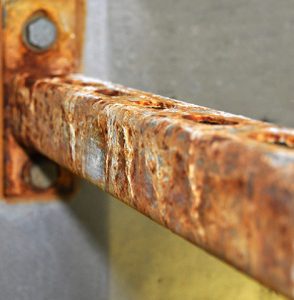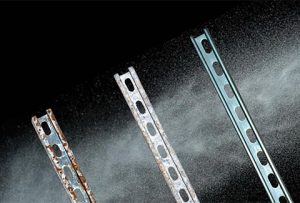Corrosion is inevitable. In a broad sense, it is the gradual deterioration of materials (primarily metals) through reactions with their environments. When left unchecked, corrosion can cause significant impairments, such as the loss of a building’s structural integrity, which can be extremely costly to repair and, more importantly, increased risk of workers safety. With this in mind, you probably want to know how to prevent corrosion from taking place. Before we jump into that, let’s learn a bit about the cause and process of corrosion.

Most commonly, electrochemical corrosion occurs when most atoms on the metal’s surface lose electrons to oxygen (mainly with the air or water), becoming oxidised as it forms an oxide, which damages the metal’s surface entirely. Many causes contribute to general corrosion, including:
Some metals can get damaged quite easily to these causes through corrosion, whilst other metals are very resistant due to their natural passivity (corrosion resistance). Therefore, it’s essential to understand the metal’s environment and the type of metal being used.
Depending on the metal type, surface protection, and environment, corrosion can take place over a couple of years to, in the more extreme metal to environment incompatibility, within a few months. This deterioration of metals can cause significant financial and safety consequences, including high costs in amending corrosion damages, waste of valuable resources, machine and plant downtime to repair, and reduction of structure’s integrity that can lead to risking workers’ safety amongst others.

Despite corrosion being nearly impossible to stop, proper planning and design methods before installations significantly help in prolonging the effects of corrosion, in some cases, for 20 years or longer. By identifying the environmental conditions of the installations using the ISO 12944-2 guidelines and applying the appropriate surface protection and metal type for the environmental conditions, you’ll be able to ensure long-lasting quality, cost savings, and increased workers’ safety amongst new and old installations.
The first step is to understand the environment. Various environment types are defined according to ISO 12944-2 depending on the severity of the corrosion factors present, with C1 being with almost no corrosion factors to CX with extreme corrosive conditions. By carrying out this planning, based on the table below, this sets the basis for the rest of the installation design, including selecting the materials and surface protection which can save unnecessary costs and time.
| Applications* | Corrosivity class** |
|---|---|
| Dry Indoor spaces | C1, C2 |
| Indoor spaces with occasional condensation | C1, C2 |
| Outdoor areas with low pollution | C2, C3 |
| Outdoor areas with moderate pollution | C3, C4 |
| Coastal areas | C4, C5, CX |
| Outdoor areas with heavy pollution | C4, C5, CX |
| Extreme/special applications |
After determining the corrosivity of your environment, the next step is to consider which surface protection method is the most suitable for it. In the market, there are several options available. These include but are not limited to
halogenic ions like fluorine. The latter is important, as while A2 graded metals are recommended to be cleaned only with clean water, the A4 grade can be cleaned with water containing chemicals.
At Walraven, next to having decades of experience in surface protection and deep expertise in the installations market, we also provide surface protection products for your project needs. For example, for environments C1-C2, one of the options available is an affordable yet durable range of zinc-coated fixings, which can withstand about 100 hours of salt spray test*. When it comes to harsher environments, we offer the options of Hot dip galvanised fixings (durable up to 600 hours of salt spray test*) and the in-house created BIS UltraProtect® 1000. The latter is suitable for both indoor and outdoor use and is unique in terms of scope, composition and corrosion resistance compared to similar surface protections. BIS UltraProtect® 1000 features an organic layer that protects against many different types of pollution and withstands 1,000 hours of salt spray test*.
For more extreme environments, we offer a complete range of A4 graded Stainless Steel for most application areas, ensuring lifetime guarantee and safety under virtually any conditions. See table below for guidance on which surface protection method to apply depending on the corrosivity of the environment.
| Applications* | Corrosivity class** | Zinc coatting | Hot dip galvanized | BUP (Bis UltraProtect 1000) | Stainless Steel |
|---|---|---|---|---|---|
| Dry Indoor spaces | C1, C2 | ✔ | ✔ | ✔ | ✔ |
| Indoor spaces with occasional condensation | C1, C2 | ✔ | ✔ | ✔ | ✔ |
| Outdoor areas with low pollution | C2, C3 | ✔ | ✔ | ✔ | |
| Outdoor areas with moderate pollution | C3, C4 | ✔** | ✔ | ||
| Coastral areas | C4, C5, CX | ✔ | |||
| Outdoor areas with heavy pollution | C4, C5, CX | ✔ | |||
| Extreme/special applications | Please consult us for more information | ||||
We believe in ensuring high-quality surface protection across all environmental situations and our entire product portfolio. Ease of installation is the essence of our product design, making installation on the field as safe and fast as possible, as well as offering appropriate support for the design, pre-assembly of the system, and general support before and after installation completion.